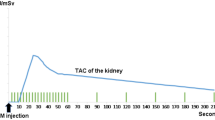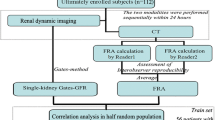Abstract
The aim of this work is to correlate the net kidney uptake of99mTc-aprotinin (TcA) in 103 subjects with separate effective renal plasma flow (ERPF) and some blood chemistry parameters at 90, 180, and 360 min postinjection both in the normal and diseased kidney. Correlations found with separate ERPFs are highly significant at any time (P < 0.001). However, although the slope of the regression line is steeper at 180 min,r tends to deteriorate slightly with time postinjection and a higher intercept on they axis: this pattern is more pronounced if diseased kidneys are considered separately. The following are probably related to the renal handling of TcA: (1) Early scans better reflect blood flow to the kidney, while later scans are more related to the metabolism/excretion tubular mechanisms; (2) correlations found with urea, creatinine, urea clearance, and creatinine clearance are highly significant at any time; (3) in 20 additional patients with diseased kidneys, renal uptake measurements done 360 min postinjection first with TcA and then with DMSA showed better correlations with ERPF employing TcA. Our results indicate that TcA is a feasible indicator of split renal function even at 90 min postinjection when a scan is easily carried out on an outpatient basis.
Similar content being viewed by others
References
Aprile C, Saponaro R, Villa G, Lunghi F (1983) In vivo comparative evaluation of aprotinin and DMSA labelled with99mTc. In: Colombetti LG (ed) Proceedings of the Third International Symposium on Radiopharmacology. Freiburg, September 21–25, p 5 (abstr)
Aprile C, Saponaro R, Villa G, Lunghi, F (1984)99mTc-Aprotinin: Comparison with99mTc-DMSA in normal and diseased kidneys. Nucl Med 23:22–26
Bellitto L, Donadio C, Tramonti G, Lorusso P, Lunghi F, Zito F, Bianchi C (1983) Aprotinin-99m Tc: A new radiopharmaceutical for the study of kidney morphology and function. In: Deutsch E, Nicolini M, Wagner HN jr (eds) Technetium in chemistry and nuclear medicine. Cortina International, Verona, pp 171–173
Bianchi C, Donadio C, Tramonti G, Lorusso L, Bellitto L, Lunghi F, Pilo A (1981) Aprotinin-99 m Tc: A new tracer for the study of kidney morphology. Eur J Nucl Med 6:A5 (abstr)
Bianchi C, Donadio C, Tramonti G, Lorusso P, Bellitto L, Lunghi F (1982) Aprotinin-Tc 99 m: A new tracer for kidney imaging and unilateral renal function studies. In: Raynaud C (ed) Nuclear medicine and biology. Pergamon Press, Paris, pp 2756–2760
Bianchi C, Donadio C, Tramonti G, Lorusso P, Bellitto L, Lunghi F (1984a)99mTc-aprotinin: A new tracer for kidney morphology and function. Eur J Nucl Med 9:257–260
Bianchi C, Donadio C, Tramonti G, Lorusso P, Guzzardi R (1984b) Is the noninvasive measurement of renal clearance of low molecular weight proteins possible? Preliminary results in man. Eur J Nucl Med 9:A69 (abstr)
Chervu LR, Blaufox MD (1982) Renal radiopharmaceuticals: An update. Sem Nucl Med 2:224–245
Cox PH (1982) Technetium complexes for renal scintigraphy. In: Cox PH (ed) Progress in radiopharmacology, Vol. 3. Martinus Nijhoff, The Hague, pp 31–44
Cox PH (1984) Aprotinina: A new reagent for scintigraphy of the kidney. Eur J Nucl Med 9:A4 (abstr)
Janoki GA, Kocsar L, Spett B, Kutas B (1978) Localization of the polypeptide aprotinin (Gordox) in the renal cortex: A new renal agent for scintigraphy. In: Colombetti LG (ed) Proceedings of the First International Symposium on Radiopharmacology. Innsbruck, May 21–24, p 23 (abstr)
La Ferla GA, Murray WR (1984) Anaphylactic reaction to aprotinin despite negative ocular sensitivity tests. Br Med J 289:1176–1177
Massin JP (1979) A single tracer method for background subtraction in197Hg Cl 2 renal uptake measurement. Eur J Nucl Med 4:333–338
Meldolesi U, Mombelli L, Roncari G, Conte L, (1977) A simple method for estimating renal clearance by renography. J Nucl Biol Med 17:79–83
Meldolesi U, Casucci R, Comotti L (1977) An analysis of the diagnostic contribution of double compound renography. Eur J Nucl Med 2:63–66
Mogielnicki RP, Waldmann TA, Strober W (1971) Renal handling of low molecular weight proteins. I L-chain metabolism in experimental renal disease. J Clin Invest 50:901–909
Pedroso de Lima J, Segura Moreira A (1976) O Trasylol-Tc 99 m na visualizacao cintigrafica dos rins. Medicina 1:337–381
Piers DA, van Luyk WHJ, Donker AJM, Meyer S, Sluiter WJ (1984) The renal uptake of99mTc-DMSA: Evidence for glomerular filtration and tubular reabsorption. Eur J Nucl Med 9:A67 (abstr)
Author information
Authors and Affiliations
Rights and permissions
About this article
Cite this article
Aprile, C., Saponaro, R., Villa, G. et al. Assessment of split renal function with99mTc-aprotinin. Eur J Nucl Med 12, 37–40 (1986). https://doi.org/10.1007/BF00638793
Received:
Issue Date:
DOI: https://doi.org/10.1007/BF00638793




